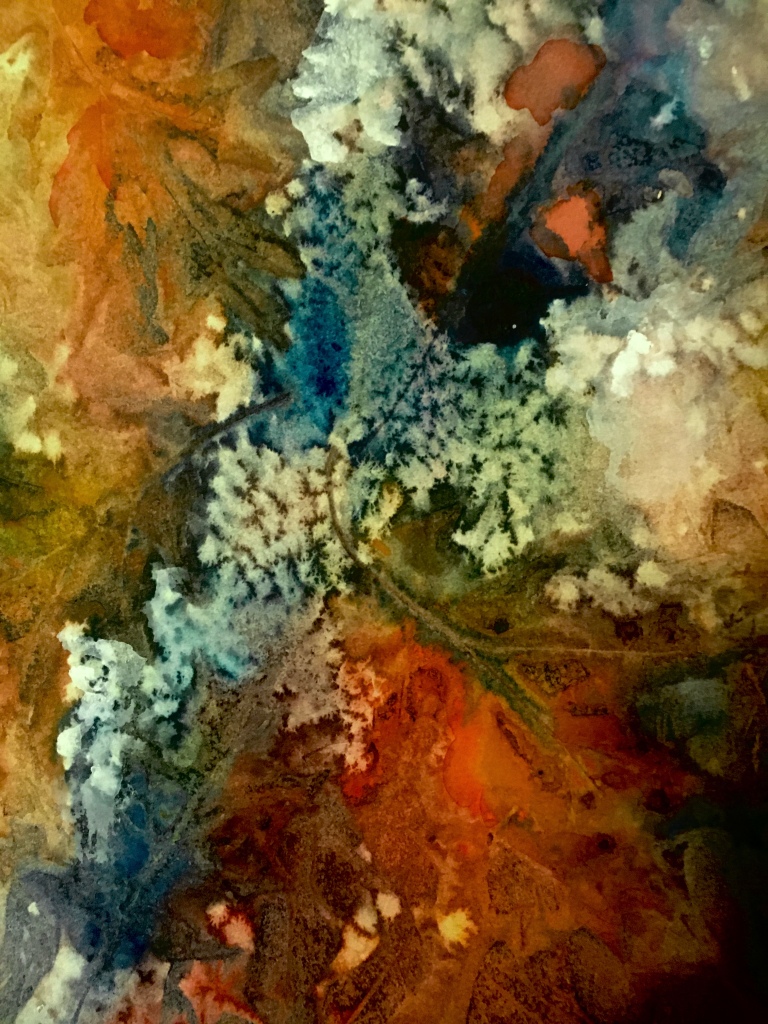
Almost a year — and what a year! I had decided never to blog again, as I so love NOT having to sit at my computer, when I have so many fun hands-on things to do. But in recent days, a current issue surfaced that I simply had to address or I would not have been able to live with myself. Yesterday, I posted that issue on my NORTHERN REFLECTIONS blog. Today, because an art blog is the most fun of all, I am here—back again.
Ever since I can recall, I have been besotted with leaves–especially those that drift from the trees in autumn. As a child, I colored fresh-fallen moist leaves with my crayons, and then pressed the colored leaves onto white cloth with a hot iron. For decades I have been gathering the perfect specimens of autumn bounty, and drying them beneath pages of heavy books. In recent years, I have made collages with these dried leaves on gallery wrap canvas panels, adding acrylic paints and a final fixative before hanging on the wall..
So for me, leaf art is nothing new. But this last fall, I was tardy in my gathering. By the time I was rustling and crunching around in the fallen leaves they were mainly dried, curled, and FRACTURED. Thus the idea of “Fractured Leaf Art” was hatched. The results were so intriguing, so nurturing to my voracious appetite for the abstract that I may never look back!
There are no two Fractured Leaf Paintings alike. And the process is so basic that any six-year-old, given the need for patience between stages, can produce a painting to be proud of. Since I have many young people in my family, I am eager and excited to share THE PROCESS!
I quickly discovered that the best Fractured Leaf Paintings (in my opinion) are achieved on Yupo Paper–that odd, shiny surface that is not paper but rather a “poly . . . . something”, in other words a kind of plastic. I spray the Yupo with clear water, and then spread 2 or 3 watercolors of my choice randomly around the surface, tilting the piece and causing the colors to merge. Then I press the fractured leaves or pieces of leaves onto the wet paint–again randomly. To this beginning I sporadically add more paint colors and salt, and press plastic food wrap (like Saran) over the entire surface. With my fingers, I crinkle and bunch up the food wrap, creating bubbles, creases, and a myriad of lines. This whole bit gets weighted down with heavy books, jars of brushes, or anything else with heft.
After a couple of days, I tentatively remove the food wrap to see if the surface is dry. Obviously Yupo takes longer to dry than normal watercolor paper, because the Yupo is not absorbent. When everything is really dry, I remove the leaves and scrape off the salt with an old credit card. Voila! Fractured Leaf Art.
At this point the painting may need a little tweaking, perhaps some more paint or the emphasis of a few lines or branches along the creases made by the food wrap.* Or the piece may be gorgeous as is. In the above pictured painting, I did not tweak. To me the painting was just right in its natural state, and realizing my tendency to overwork my art I decided to add no more.
Always, when using Yupo I spray the work with an acrylic fixative. While not striving for museums, I do want my art to last for at least a couple of lifetimes.
So you might have a go at Fractured Leaf Art. I definitely live in a four season zone. (Wisconsin: Spring, Summer, Autumn, and Winter/Winter/Winter.) Different locales have different trees, and it would be fun to expand my leaf knowledge. Perhaps my Florida family members will bring me some palm leaves.
Margaret L. Been — January 14, 2021
*When adding branches or lines, I have discovered a trick of using a DERWENT INKTENSE PENCIL which has been dampened, rather than a paint brush. The damp ink pencil adds a soft, blurry line rather than a harsh one. I favor organic as opposed to the popular geometric style of abstract art.
**An excellent Austrian fine artist does amazing paintings using all kinds of wild materials gleaned from her nature hikes. You can check out this mixed media artist and her books by GOOGLING her name, Waltraud Nawratil. You will not be disappointed.













